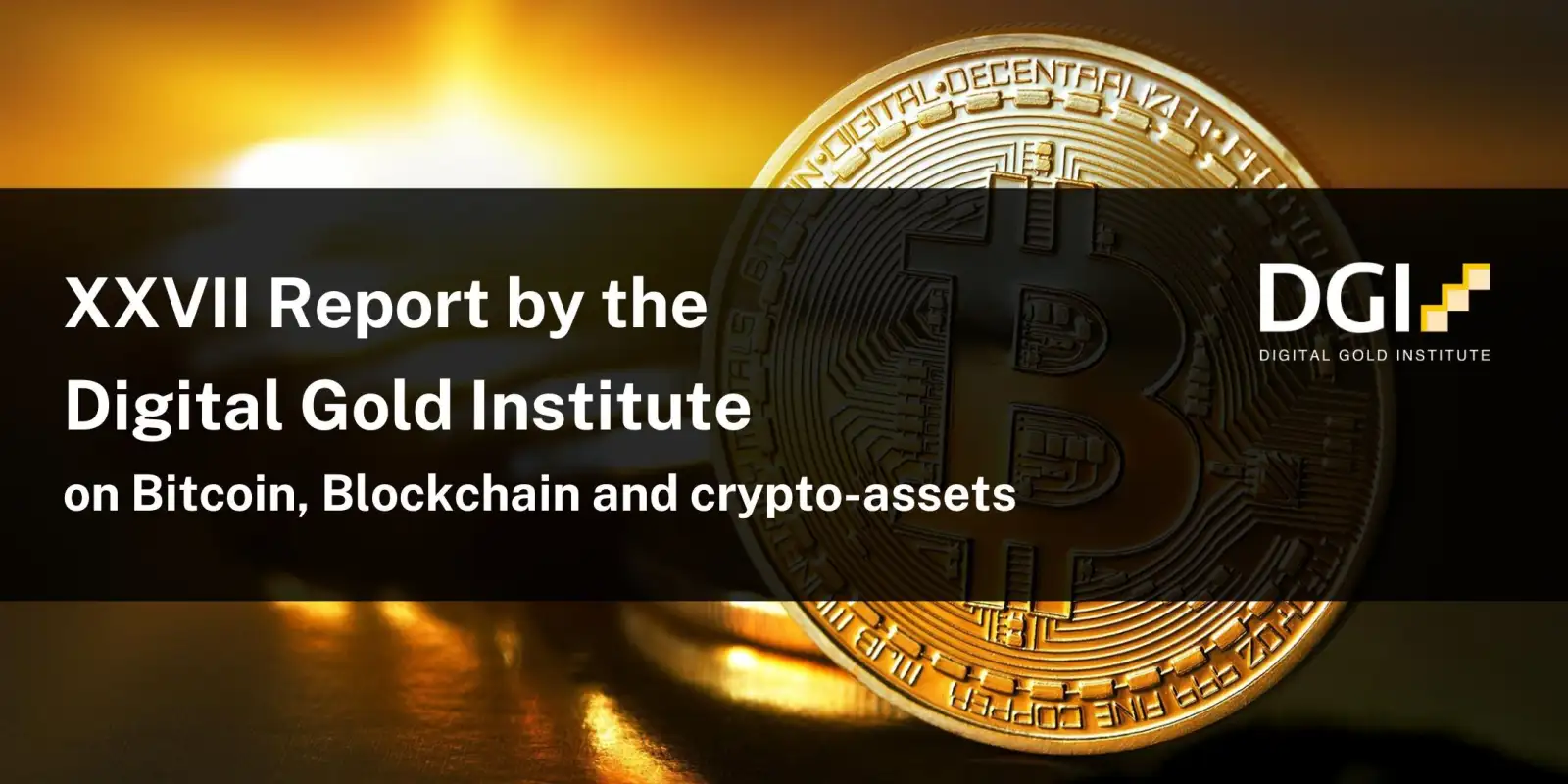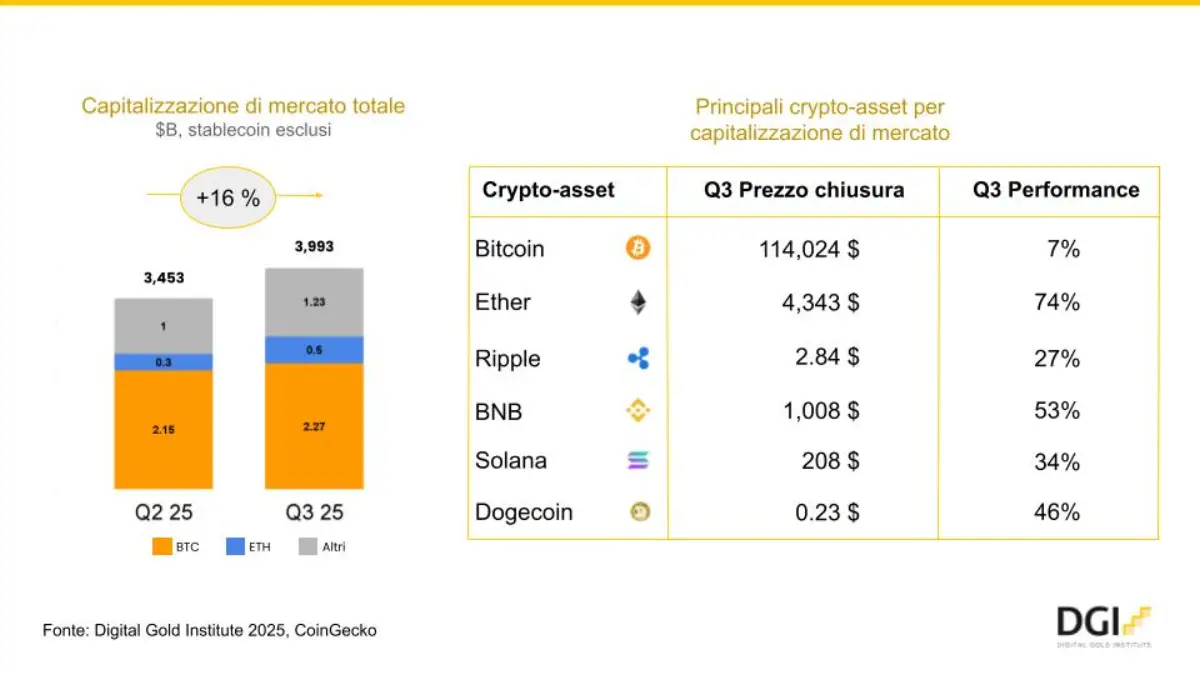XXVII Quarterly Report on Bitcoin, Crypto Assets, and Blockchain

October 8, 2025 - Staff
Crypto Market: Ether takes the lead, Bitcoin consolidates its dominance
The Digital Gold Institute releases its 27th quarterly report: altcoins surge, the market grows increasingly institutional, and stablecoins take center stage globally.
Milan, October 8, 2025 – The Digital Gold Institute (DGI), the research division of CheckSig and Europe’s leading think tank specializing in Bitcoin, crypto assets, and blockchain, has published the twenty-seventh edition of its quarterly report on the crypto ecosystem.
The third quarter of 2025 confirms the dynamism of the crypto market. Ether led performance with a record +74% gain, reaching a new all-time high above $4,900, while Bitcoin consolidated its dominance. Institutional interest continues to grow, stablecoins emerge as key instruments, and family offices explore new diversification strategies.
Market: Ether leads, Bitcoin consolidates
In the third quarter of 2025, Ether stood out as the main performer, posting a record +74% gain and setting a new all-time high above $4,900. Bitcoin, consolidating its levels from previous months, reached a market capitalization of approximately $2.27 trillion. Major altcoins also recorded gains exceeding +27%, contributing to an overall market capitalization increase of +16%, surpassing $3.9 trillion. Ether ETFs saw record net inflows, highlighting growing interest from institutional investors. Nonetheless, Bitcoin remains the primary benchmark for institutional allocations.

Ferdinando Ametrano, Scientific Director of the Digital Gold Institute, commented: “This quarter confirmed Ether as the market’s leading asset: technological upgrades and record ETF inflows have significantly increased investor attention. Bitcoin remains the dominant asset, but Ether drove returns during the period.”
A more institutional crypto market
Openbank, the digital bank of the Santander Group, has recently launched crypto services for its clients in Germany, with plans to expand into Spain, operating fully under the European MiCA framework, for which it has obtained a formal license. Other major Spanish institutions, including BBVA, also offer regulated crypto services, underscoring Spain’s leadership in the digital transformation of the banking sector.
In public markets, Gemini’s listing on Nasdaq, priced at $28 per share and raising $425 million, values the platform at approximately $3.3 billion. The move follows recent IPOs by Circle and the inclusion of Coinbase in the S&P 500, confirming growing institutional interest and the robust momentum of the crypto industry in public equity markets.
The global stablecoin landscape
The stablecoin market continues to evolve worldwide. In the United States, the GENIUS Act has established a clear regulatory framework, requiring issuers to maintain full reserves, undergo audits, and comply with anti-money laundering regulations. In response, Tether has launched USAT, a stablecoin designed specifically for the U.S. market, managed by Anchorage Digital Bank with reserves held by Cantor Fitzgerald.
In Asia, China is advancing with its offshore yuan-linked stablecoin, AxCNH, launched in Kazakhstan in September 2025 by AnchorX. The initiative aims to reduce reliance on the U.S. dollar, despite China’s domestic ban on cryptocurrencies. In Europe, where the digital euro project remains slow-moving, banks are taking the initiative: nine financial institutions are collaborating to develop a euro-denominated stablecoin, seeking to bridge the gap and maintain competitiveness on a global scale.
Asset allocation for large family offices
The session concluded with remarks by Alex Pezzoli, Founder and CEO of Brightside Capital, a leading Swiss Multi-Family Office, who offered an analysis of the global macroeconomic landscape and its implications for long-term wealth management. Pezzoli emphasized that gold and “digital gold” (Bitcoin) are now essential instruments for preserving, diversifying, and ensuring the generational continuity of substantial family wealth.
“Including Bitcoin and gold in family office portfolios represents an asymmetric strategic allocation,” said Pezzoli. “A 0.5%–1.5% allocation can virtually eliminate the risk of permanent capital loss in adverse scenarios, while—if the long-term vision proves correct—it could significantly enhance expected returns over a 5–10 year horizon. It’s a low-cost positioning choice, but potentially transformative in outcome.”
The video presentation of the XXVII report is available at this link. The next Digital Gold Institute quarterly report will be released in January 2026.